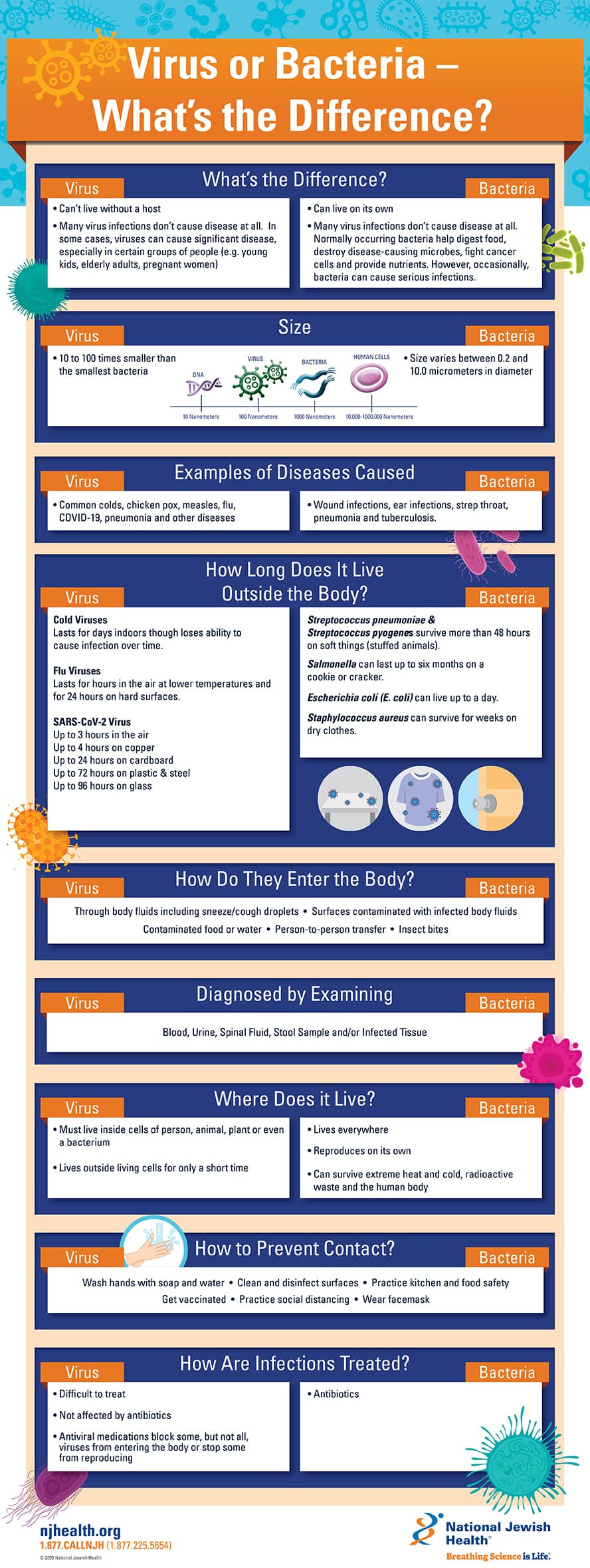This information has been reviewed and approved by Reeti Khare, PhD (March 2024).
What’s the Difference?
- Can't replicate without a host, but can live on surfaces
- Many virus infections don’t cause symptoms at all. In some cases, viruses can cause significant disease, especially in certain groups of people (such as young kids, elderly adults, pregnant women).
| - Can live on its own.
- Normally occurring bacteria help digest food, can destroy disease-causing microbes, fight cancer cells and provide nutrients. However, bacteria can occasionally cause serious infections.
|
How Big?
- 10 to 100 times smaller than the smallest bacteria
| - Size varies between 0.2 and 10.0 micrometers in diameter
|
Examples of Diseases Caused
- Common colds, chicken pox, measles, flu, COVID-19, pneumonia and other diseases
| - Wound infections, ear infections, strep throat, pneumonia and tuberculosis
|
How Long Does It Live Outside the Body?
Viruses don’t “live” (i.e., reproduce) outside the body but they may exist for days on external surfaces until they degrade or find a host. Cold Viruses - Lasts for days indoors though loses ability to cause infection over time
Flu Viruses - Lasts for hours in the air at lower temperatures and for 24 hours on hard surfaces
Sars-Cov-2 Virus - Up to 3 hours in the air
- Up to 4 hours on copper
- Up to 24 hours on cardboard
- Up to 48 hours on steel
- Up to 72 hours on plastic
- Up to 96 hours on glass
| Bacteria can survive independently, but they will die if they don’t find the right environmental conditions for growth. - Streotococcus pneumoniae & S. pyogenes survive more than 48 hours on soft things (stuffed animals).
- Salmonella can last up to six months on a cookie or cracker.
- Escherichia coli (E. coli) can live up to a day
- Staphylococcus aureus can survive for weeks on dry clothes.
|
How Do they Enter the Body?
Direct contact with infected body fluids or lesions
Indirect contact with contaminated surfaces
Inhalation (contaminated air or droplets)
Contaminated food or water
Animal or insect bites |
Diagnosed by Examining
Blood and body fluids, like cerebrospinal fluid, swabs from the respiratory tract, swabs from lesions, urine, stool and infected tissue |
Where Does it Live?
- Must live inside cells of a person, animal, plant or even a bacterium
- Survives outside living cells for a short time, but cannot reproduce on its own
| - Can grow and reproduce on its own
- Can grow and reproduce in the human body and in human cells
- Some can live in extreme hot, cold or even radioactive environments
|
How to Prevent Contact?
Wash hands with soap and water
Clean and disinfect surfaces
Practice kitchen and food safety
Get vaccinated
Practice social distancing
Wear facemask |
How Are Infections Treated?
- Difficult to treat
- Not affected by antibiotics
- Antiviral medications block some, but not all, viruses from entering the body or stop some from reproducing
| |

